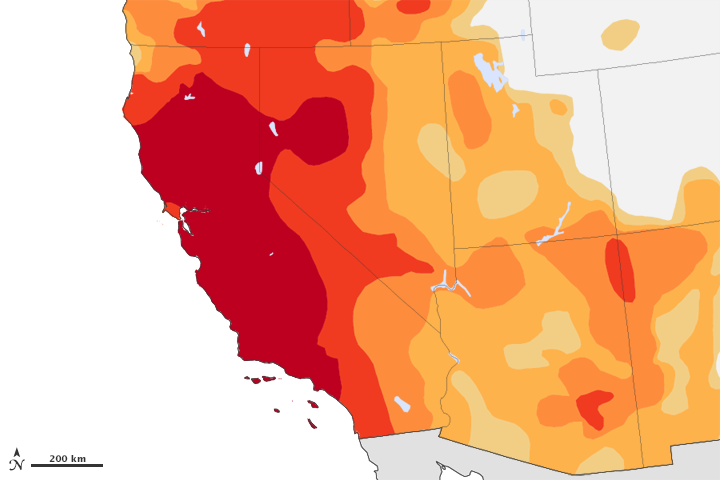


According to the U.S. Drought Monitor, 11 of the past 14 years have been drought years in the American Southwest. The biggest headlines this year—and the worst levels of drought—can be found in California, but most of the region has been suffering from a persistent lack of rain and snow. More than 64 million people are directly affected by drought in the Southwest and Southern Plains, and far more are indirectly affected because of the vast number of farms, orchards, and ranches that supply the rest of the United States.
The maps above show drought severity in seven key states as of November 16, 2014. The Drought Monitor compiles and analyzes measurements of climate, soil, and water conditions from more than 350 federal, state, and local observers around the country. The maps show drought stages areas in progressive shades of orange to red.
On November 16, 2014, the entire state of California was in some stage of drought; that has been the case since April 2014. Despite some recent rain in northern California, 79.69 percent was in extreme drought and 55.08 was classified with exceptional drought. Those numbers are down slightly from 81.92 extreme and 58.41 exceptional drought from late July through late October. In water year 2014 (October 1, 2013, to September 30, 2014), California received just 20 percent of normal rainfall and 18 percent of it snowpack; reservoirs in the state collectively stood at 57 percent of capacity. The past three years have been the driest in California history, and 2014 is shaping up to be the hottest on record.
Conditions were difficult, though not quite as drastic, in the following states:
In its weekly summary, the Drought Monitor reported:
The current Water Year has been largely a disappointment in central and southern portions of the region...The 2014-15 Water Year has afforded little—if any—drought relief to California...The current Water Year has gotten off to an abysmal start...The dry, mostly mild start to the winter has left snowpacks in the Sierra Nevada well short of normal. The dryness has been exacerbated by Santa Ana winds...In the Great Basin and Four Corners, there were no changes to this week’s drought depiction despite the very poor start to the current Water Year, particularly in western portions of the region. The season’s poor initial prospects are reflected by season-to-date precipitation...with most areas reporting less than 30 percent of normal. Changes to the drought depiction across much of the West are typically slow to occur during the early part of winter, as the development of the Water Year will be crucial to the region’s drought relief (or development) prospects.
The U.S. Drought Monitor is a partnership of U.S. Department of Agriculture, the National Oceanic and Atmospheric Administration, and the University of Nebraska-Lincoln. NASA also provides experimental measurements and models to the drought monitoring effort.
Maps by Jesse Allen, using data provided by the United States Drought Monitor service at University of Nebraska, Lincoln. Caption by Michael Carlowicz.